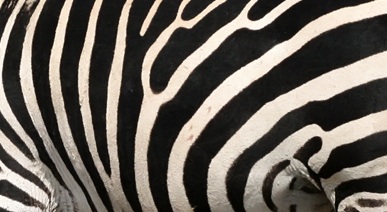Science News
Zebra Barcodes and Beetle-Man

It was only a matter of time… New Scientist reported earlier this week that computer scientists have discovered a new-ish way of identifying zebras in the wild or from a photograph. Since each zebra has unique striping patterns, a new technology called StripeSpotter scans the zebra like a barcode reader and inputs the information into a database. According to the article,
Other existing zebra identification systems are less accurate, more complex, and require a greater level of manual input from the user... This new system could also be applied to tigers and giraffes, or any animal with large markings in a small number of distinctive colors.
Thomas Eisner, beetle researcher, died last week. What a wonderful scientist lost, according to articles this week. If you missed the photos and stories this week, do check them out. Here is NPR’s Robert Krulwich describing only one of Eisner’s achievements:
He was among the first scientists to notice that insects communicate not only by touching and dancing and by the markings on their bodies, they also send chemical signals. Bugs talk in chemicals. And Tom, with his Cornell colleague Jerrold Meinwald, helped invent a field called Ecological Chemistry that cracked the chemical codes that drive bugs to court each other, fight each other, and give each other gifts.
Last summer we reported on the unusual symbiotic relationship between a certain salamander and a certain algae. This week, researchers (including one from this science writer’s alma mater, Indiana University) publishing in the Proceedings of the National Academy of Sciences, describe how deeply this relationship goes. The algae have been found to live inside the cells of developing salamander embryos—the first known example of a eukaryotic algae living stably inside the cells of any vertebrate. Ed Yong writes in Discover that, “How the algae get into the egg in the first place is a mystery.” But the organisms don’t seem to mind, according to 80beats:
…each species benefits from the presence of the other. In order to develop normally, salamander embryos need oxygen, which the algae produces. The algae needs lots of nitrogen and a place to stay, and salamander cells meet both criteria.
Finally, around Barack Obama’s inauguration a couple of years ago, we interviewed Richard Muller about his Physics for Future Presidents book and course at UC Berkeley. A new interview, in this week’s ScienceInsider, provides more background on Muller and interesting insight into his recent testimony on climate change in front the science committee of the House of Representatives. Here’s part of the introduction to the interview:
Republicans expected Muller to challenge the accepted wisdom that the earth has warmed 0.7˚C since the 1880s. But to the dismay of skeptic bloggers, his preliminary analysis supports that canonical view.
Whistle-whetted? Go check it out.
Image by Muhammad Mahdi Karim/Wikimedia